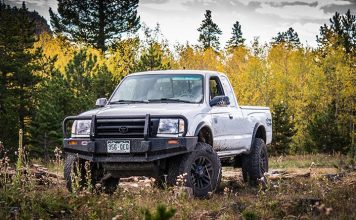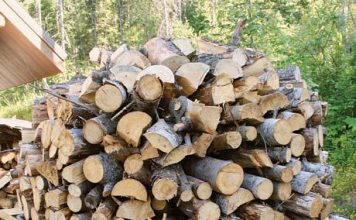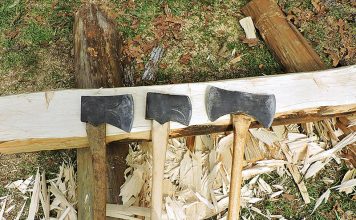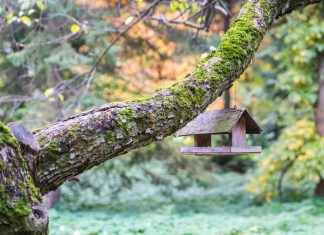| Issue #140 • March/April, 2013 |
My friend Jack pulled the car into a grassy clearing. We donned rubber boots, fetched a metal detector and digging tools from the trunk, and headed off along a game trail. Our mission: To dig up and test fire a pistol Jack had buried years ago.
The trail disappeared into a wetland, which Jack crossed with confidence. The muddy water was only about six inches deep where he walked, but I couldn’t see the bottom so I waded gingerly after him. It was at this point I discovered that my borrowed waterproof boots weren’t. I squished along after Jack. By the time I emerged onto dry land, he was standing well ahead of me, next to the stump of an old cedar that had been logged a hundred years ago.
“It’s buried right here,” Jack told me confidently. “Between this stump and that sapling.”
I was dubious. The “sapling” wasn’t exactly a sapling anymore. It had grown into a mid-sized alder tree. Besides, Jack had history with not being able to relocate a buried firearm. Back in 2004, I had mocked him in one of my Backwoods Home Hardyville columns for that very thing, an SKS he couldn’t relocate.
Nevertheless, he set to breaking up roots. I followed with a shovel.
“I didn’t bury it very deep,” he said. “We shouldn’t have too much trouble.”
They’re at it again. The politicians in Washington, DC, and their media mouthpieces everywhere are in full cry, threatening more restrictions on our right to own guns.
In response, Americans are rushing to buy firearms, particularly those that might be targets of the next ban. Without a doubt, many guns are going underground or into other hiding places. When Draconian restrictions take effect, millions more firearms will get tucked into walls, haylofts, hollow trees, and waterproof containers buried in the woods.
There are people who say, “When it’s time to bury the guns, it’s actually time to dig them up and use them.” They have a point. But in fact, there are plenty of good reasons to hide guns, now or at any other time. And we’re not talking about simply concealing a gun to have it handy in home, office, or hotel room. We’re talking about hardcore, long-term hiding stashing guns against some urgent future need.

My friend Jack, carrying a metal detector and digging implements, heads toward a game trail that leads to the site where he buried a pistol many years ago. The game trail is right in front of him but strangers would be unlikely to spot it because of the quick-growing blackberry bramble that’s obscured it.
Three reasons to hide a gun
You might want to hide a firearm just to have a spare if your others get stolen or damaged in a disaster.
You might want to hide a firearm if you are a peaceable person who is nevertheless forbidden to own a gun because of some misdeed in your past or some arbitrary state law.
And of course, you might want to hide a firearm if you fear nationwide bans and confiscations but realize that you can’t stand alone against the gun banners.
Three types of guns you might want to hide
You might want to hide a spare carry pistol away from your home in case your everyday carry gun is stolen or damaged.
You might want to hide any firearm that’s being banned.
Or as in the Clinton era, the last time people rushed to hide firearms you might want to stash any cheap, but reliable semi-automatic rifle in a common caliber. SKSs were popular stash guns then. AK-47s are good, too. You probably don’t want to tuck away your best battle rifle or your most beautiful, precise, scoped bolt action hunting gun (or, as politicians will eventually call it, your “sniper rifle”). But that’s up to what you can afford to sequester and what you want to have at hand if the you-know-what ever hits the rotary airfoil. Because, make no mistake, a buried battle gun is a SHTF tool.
And of course, in all cases, you’re also securing ammunition for that gun and any tools you might need to make your well-hidden firearm work for you.
Whatever type of gun you choose, one of the most important steps is to prepare it well for long-term storage. You need to ensure that the firearm you eventually retrieve will be ready to use and not a rusted hulk.
Three ways to prep your gun for hiding
My friend Jack favors the very simplest method of preparing a firearm for hiding. He leaves the gun fully assembled, wraps it in vapor-phase inhibitor paper (also known as volatile corrosion inhibitor or VCI paper), adds desiccants (see sidebar) to keep down humidity, then places gun and ammo into a tightly-sealed container. His SKS spent nearly 10 years underground in this condition and was perfectly fine and ready to shoot once he finally he unearthed it.
Still, such a casual approach horrifies a lot of people and it definitely lacks failsafes. My own preference: disassemble the firearm, coat every bit with a film of high quality gun oil like Break-Free, wrap each part separately, and then seal everything in a waterproof container with desiccants. Some people I’ve known take the extra step of pulling oxygen out of the container using a vacuum or piece of dry ice. You can also get VCI corrosion-resistant gun bags (including more pricey VCI vacuum bags) from places like MidwayUSA.com or Brownells.
Some old-timers I know disassemble their guns for hiding, but instead of coating parts with Break-Free, they use Cosmoline. Cosmoline is the now nearly-generic term for a brown, gooey, Vaseline-like preservative that’s been used for decades to rustproof firearms. You may have encountered it if you ever bought a surplus military rifle. Commonly, such rifles have been literally dipped in a vat of Cosmoline at some point and will have the goop in every cranny even after being superficially cleaned. You might want to go the Cosmoline route if you expect your firearm to be hidden for a really long time for instance, if you intend it for your yet-unborn grandchild. You can buy Cosmoline or similar pricey, corrosion-proofing preservatives online. But if you go that way, whoever resurrects the gun will need to have mineral spirits, a soaking tub, and brushes on hand.
Any time you store a gun disassembled, you need to store any tools required to clean and reassemble it. Maybe instructions, too. I know I might forget how to reassemble a gun that I hadn’t touched in years.
Three types of storage containers
An appropriate storage container depends on your climate and where you plan to hide your gun.
One of the most popular and secure methods of gun hiding is burying. And the most popular container for burying a gun is ordinary Schedule-40 PVC pipe from any hardware store or plumbing supply store. You’ll need a piece of pipe with sufficient diameter and length to hold your firearm, ammunition, and tools (unless you plan to store the ammo and tools separately). You’ll also need end caps and sealant. Preferably you’ll buy all this where you’re not known, and you’ll use cash, not a check or credit card. One of the caps should be permanently sealed on. The second cap may be a threaded one with a rubber gasket but only if you are very sure of an excellent seal. My friend Jack cemented both ends when he buried his SKS. Then he also buried a saw nearby, wrapped in VCI paper, to open the storage tube.
In addition to being buried, a tightly sealed PVC tube can also be submerged in murky water or in a slurry. Painted with appropriate camouflage, it can be hoisted into a tree or into the rafters of a barn or otherwise used to hide its contents in plain sight.
If you’re lucky enough to find one at a gun show or surplus store, guns and other objects can also be hidden in old plastic mortar cases, which already have threaded lids with very tight rubber-gasket seals.
A pistol can be hidden in a tightly sealed metal ammo box again, well oiled and with desiccants added. This is how Jack hid the pistol we were searching for. Because it was going into damp ground, he placed the ammo can inside a larger ammo can, a plastic knockoff this time. He added desiccants to that, as well. Both ammo cans had their lids sealed with caulk. Then he wrapped the entire assembly in a plastic bag and duct-taped the heck out of it. As a final precaution, when he set everything into the ground, he upended a white plastic tub over the rest. This would turn out to be the one truly useless step.
Bonus: If your climate is very, very dry and you’re stashing a gun above ground in a spot you’re certain will never get wet, you may not need any container at all. Just place your well-oiled, VCI-wrapped firearm “naked” in its hiding place (e.g. inside a wall, under floorboards). Always include desiccants. Even in dry climates, hidey-holes can still get humid.

After two sessions of digging and detecting, this is what finally emerged from the spot where Jack and I searched. A well-sealed plastic ammo box wrapped in a trash bag and thoroughly duct-taped. Inside the plastic box is an equally well-sealed metal ammo box. Both boxes contain desiccants. Inside the metal box is a pistol wrapped in corrosion-proofing paper. Once Jack finally got all the seals opened, that pistol emerged in ready-to-fire condition.
Three places to hide a gun
The first thing to know is where not to hide a gun. Do not hide it in or around your home unless you’ve figured out a way to make it undetectable not only to opportunistic burglars, but also to metal detectors, ground-penetrating radar, and even gun-sniffing dogs (yes, there are dogs specially trained for this job; they’re actually taught to alert to gun oils, powders, or firing residue).
Of course it’s fine and routine to place everyday firearms in secure locations around the house. But remember, that’s not what we’re talking about here. We’re talking about the gun or guns that you’ll go get when the other guns are gone or when government agents are on a confiscation campaign. So unless you have extensive, difficult-to-search property, or some insanely clever and difficult hiding method, it’s best to hide firearms away from home.
Three common places are: underground, above eye level, or right in plain sight, but so disguised nobody sees what you’ve hidden.
Undergound: Because this is one of the most popular, durable, and most secure methods but also one of the trickiest we’ll spend the most time on it. You’ve prepared your firearm using one of the three methods above. You’ve sealed it inside a PVC pipe, complete with desiccants, ammo, and tools. Now what?
Find a spot where you can be unobserved.
A spot where you can be confident everything is likely to stay undisturbed for years.
A spot where nobody but you is ever likely to spend time.
A spot with landmarks you can recognize now and 10 years from now.
A spot with lots of old metal objects strewn about is a plus.
So is a spot where the soil has already been disturbed; this makes digging easier and could help foil ground-penetrating radar if anyone became serious enough about gun confiscation to try to use that against you. But disturbed ground is optional and may not be ideal for other reasons. It may be in a place with too much traffic, for instance. You can’t have everything, so make your own best choices.
Your chosen caching location might be in the woods. Or an old, disused junkyard. Could be the grounds of an abandoned factory. Or a high sandy ledge in a desert canyon. Could be property belonging to a law-abiding relative (less likely to come under scrutiny than you and your own property).
Now, having found the ideal spot, dig. There are two schools of thought on this, particularly when burying a rifle: vertical and horizontal.
Inserting that precious PVC tube into the ground vertically gives your gun a much smaller and much less gun-like signature to metal detectors. That’s good. Unfortunately, it’s also much harder to dig a deep enough hole. Superman with a manual post-holer could do it. But you may need a mechanical auger.
To further compound the problem, your container should go entirely below the local frost line which in places like Wisconsin can be as deep as four feet. And that’s for the top of the container. Bury too shallowly and frost heave could crack your container or eventually thrust it to the surface.
Unburying a vertically buried container can also be a problem. Even after you’ve uncovered the first foot or so of the tube, the ground is going to cling hard. You might need a winch, a hand-cranked come-along, a rope, or at least a lot of muscle to haul your stash out of the ground. (See Charles Wood’s excellent article in Issue #115 (Jan/Feb 2009) of Backwoods Home for more helpful details on burying and unburying firearms. He used the vertical method.)
In the Pacific Northwest, where my friend Jack buried his guns, it’s less of a problem. The ground doesn’t freeze more than a few inches down. Nevertheless, Jack opted for the easy method when he hid his SKS. He went horizontal. This is where having a lot of metal debris in the vicinity really helps to hide the telltale signature of a long, narrow object like a rifle.
After burying, be sure to cover the spot with the native topsoil, leaves, needles, bark, or metal garbage to disguise it.
Above eye level: It’s a funny thing; people don’t look up. You can hide something in a tree or in rafters. You can hide something in the clerestory of an old factory or warehouse. Or in the trim at the top of a building. Or even in a false gutter on a house. And unless they’re really determinedly searching for it, people simply won’t see it because they don’t look up. Of course, it’s still best to use camouflage techniques when hiding firearms in such places. Also, when it comes to trees or old buildings, you should consider these only as temporary hiding places a few years, at most. Buildings get demolished. Trees are logged or fall over in storms. When you hide in such places, you need to go back frequently to check on your stash and that itself can compromise security.
In plain sight: Above eye level isn’t the only place you can hide something in plain sight. A reader of my blog told about U.S. soldiers finding a rifle in an old heap of junk in Iraq. Its barrel had been protruding out of the garbage for months before anybody realized what it was. Then they pulled it out and found that it fired perfectly.
Plain sight doesn’t necessarily mean your firearm is “right out there,” either. It can mean misdirection. For instance, you could stash a firearm far back on a deep shelf behind rusty old tools. Or in an ancient, obviously broken refrigerator. Or under a rusted truck. Gun parts could lie undetected for years at the bottoms of toolboxes or in junk drawers. (Always remembering moisture-proof containers, vapor-phase inhibitors, desiccants, and plenty of gun oil.)
Take advantage of local features, too. For instance, if you live in an area that has stone walls, you may find that some of these have loose gravel centers perfect places to stash a gun. Lonely ponds and hollow stumps can be fine hiding places if your container is 100% waterproof. Use your imagination and your local geography.
There are thousands of possible places and ways to hide guns. As my friend Jack learned from his SKS misadventure, the real problem isn’t hiding a gun. It’s finding it again. Which brings us back to the gun-seeking expedition that opened this article.
As Jack and I dug (and dug) in search of the pistol he’d hidden between the cedar stump and the former sapling, both of us were recalling his last adventure in gun hiding.
Back in the Clinton era, he put his SKS underground and thought he was being very, very careful about memorizing its location. I’ll let him tell about that:
“I remember well the 8-inch PVC tubing, end caps glued in place, buried 13 feet northeast of a prominent rock placed in the middle of an old, private logging road. Also marked by a blaze slashed in an alder tree.
“Fast forward 10 years or so. The road had grown up in brush and trees. I’ll never know where that rock got off to, or the marked tree.” He had nothing to point to his hiding spot.
Jack brought in a cheap metal detector. No luck. He traded that in for the best metal detector he could find and went back to work. Days later … “The SKS and goodies were about 25 feet from where I’d been looking. All clean and dry, in pristine condition.”
So now, years later, we were looking for a pistol and Jack had made absolutely sure of his landmarks. That old stump that had been there for 100 years wasn’t going anywhere. Yet we dug and we dug. And we ran the metal detector in an increasingly wide circle. And we found nothing.
“I guess you’re starting to question my judgment, aren’t you?” he finally asked.
“Question it?” I laughed. “Oh no, Jack. I’ve gone way beyond merely questioning it.”
We went back to digging.

Carl Bussjaeger photo: This isolated, metal-strewn patch of woods is an ideal location for burying a gun. The rubble can help hide the signature of a buried firearm from a metal detector. In this case, the nature of the rubble the ruins of a horse-drawn wagon and a Prohibition-era moonshiner’s still also indicates that the spot has been undisturbed for a long time.
Three ways to note the location of your stash
If you have chosen a really secure hiding place, even you may have trouble finding it again. Landmarks? Don’t rely on them. Remember, trees fall or get cut down. Old cars get hauled away. Old houses and sheds collapse or get salvaged. Logging roads get re-cut, blocked off, or overgrown. Flash floods wash away even big boulders.
Today, of course, there are super-easy, high-tech ways to mark hiding spots. I can already hear younger readers saying, “Hey, I’ll just mark the spot with the GPS in my smartphone.” Easy peasy and foolish. First of all, your cellphone is a tracking device and smartphones are the worst of all. Worse, police are increasingly able to scoop up that data without warrants or other formalities. In fact (and I wish this were just paranoia, but it’s not), there’s even a growing network of “locator towers,” essentially fake cellphone towers owned and operated by law enforcement whose only purpose is to spy continuously on all of us.
So no. If you value your stash and your freedom, don’t even bring your cellphone to your hiding spot. If you do bring it, have it turned off and preferably remove its battery. Certainly do not use it to mark a location you want kept secret.
You could mark the spot with a standalone GPS unit which is not known to be owned by you and which itself is kept in a secure location. But even this is a flawed method if used by itself, since GPS units can get lost, stolen, broken, or simply wiped of data. A standalone GPS unit should be just one part of your site-marking strategy.
In previous sections, we’ve treated our “rule of threes” as an either/or. But when it comes to identifying the location of your cache and being able to find it again, one method alone is not enough. You should mark the location of your hidden weapon in three different ways. You should have a compass or a GPS unit (or both) and know how to use them.
First, identify the location visually, preferably using distant and/or virtually immovable features of the landscape. Mountain peaks, waterfalls, house-sized boulders, freeway interchanges, ancient monuments, etc. Then you can take note of nearby trees, rocks, and other objects as a backup. It’s probably more useful to make note of the terrain than features on the terrain. Note whether the ground rises or falls around your stash, or how many paces the stash is from a nearby hillock.
Second, take compass headings to your cache location from at least three different recognizable objects. Again, you should choose objects that aren’t likely to move. But if you take a heading from a power pole, a tree, and a boulder, and 10 years later the tree has fallen down, you still have other things to guide you.
In using a compass you must know the declination in your area that is, how much magnetic north varies from true north. Later, when you’re ready to go back to find your hidden tools, you should check the declination again (NOAA has a website for this). Magnetic north drifts from year to year. I was aware of this but didn’t realize how much the drift could impact caching until Carl Bussjaeger, a writer and a reader of my blog, alerted me. Then I checked. Turns out, over 10 or 15 years, the change in declination in a given area could easily be enough to put you many feet away from your hidden stuff if you don’t adjust for it. (It’s easier than it may sound, though.)
Finally, you should mark the location with your standalone GPS unit (and remember, never, ever with a cellphone). Then, when you get home, transfer those coordinates to a piece of paper or an encrypted computer file (along with your compass headings), and erase them from the GPS unit.
If you write the coordinates down, disguise them in some way. One blog reader who works in security suggested making them look like a phone number and putting them in your address book. It goes without saying that you should hide or disguise your record of the coordinates very well but not so well that you can’t find it years later. But then, that’s why you use three marking methods; if one fails, you still have the others.
Three bonus suggestions
What are desiccants?
Desiccants are essential to the safe, long-term storage of firearms. They are small objects designed to prevent humidity build-up inside sealed containers.
You’re undoubtedly familiar with one type of desiccant the little packets of silica gel crystals that come with everything from electronics to dehydrated foods. You can save those and use them when you need a dry, sealed environment. (They can help keep rust down in toolboxes, among other applications.) Heat them up a little to dry out the crystals before re-using.1
You can also get silica gel crystals and make your own desiccant packs. The crystals are sold at craft stores for drying flowers. Certain types of cat litter only those identified as “crystal litter” are made of silica gel. Just put the crystals inside a porous container and you’re ready to go. A nylon stocking will do. So will a vitamin bottle with a coffee filter replacing its lid.
In a pinch? If you’re in a hurry to stash a gun and you don’t have time or money to do anything else, just toss a cup of uncooked rice into a sock, tie the sock closed (leaving the rice as loose as possible for greater absorption), and drop it into your container before sealing.
1 A general rule is to lay the desiccant packets on a wire rack, heat them to 220 degrees in an oven for 24 hours, then store them in an airtight container. However, a lot depends on how big the desiccant packets are, what kind of desiccant they contain, and the material the packets themselves are made from. Plastic packets, for instance, might melt. And large ones might not get dry enough in that time. There are several online guides that consider the various factors.
In Britain, where they’ve lost most of their gun rights, rural folks long ago became experienced at keeping their firearms hidden. One of my blog readers from that part of the world suggests getting a roll of heavy-gauge underground cable. Dig a trench between a house and barn or house and workshop. Lay the firearm, in its waterproof PVC pipe, at the bottom of the trench, then partially backfill. Now run the cable in the trench between the two buildings about two feet above the firearm. Gun grabbers who detect metal may dig down, find the cable, and believe there’s nothing else there. “Police and soldiers hate to dig,” he notes. Here in the Pacific Northwest, where my friend Jack buried his guns, loggers often leave behind enormously thick steel cable that’s used to “yard” trees. It’s common to stumble upon great lengths of it on old logging sites. A snaky coil of that would look natural and also disguise the signature of metal underneath.
Hide a gun that not only uses common ammunition but uses common ammunition of a caliber that any potential enemy might use. In a pinch, you may need to do some “borrowing.”
Finally, keep your mouth shut. Don’t even tell people that you’ve hidden a gun, let alone where you’ve hidden it. Keep the entire act of caching on a strict need-to-know basis.
That day, we searched and searched for Jack’s hidden pistol. He and I dug for an hour between the cedar stump and the now-grown sapling. It got to the point where I feared the young alder might fall on us because we’d chopped away most of its roots. We dug pit after pit around those trees, getting occasional, hopeful blips from Jack’s metal detector.
Every once in a while we’d get excited, thinking we spotted a bit of the white plastic tub over the pistol box. But those were just learning experiences: alder roots are white inside and can look a lot like plastic fragments when you’ve been chopping at them.
“Next time, use a hot pink container.”
We dug until we were thoroughly tired, muddy, and fed up. We never did find the pistol.
Three days later, Jack went back by himself, this time carrying a long piece of sharpened rebar to probe the ground in an organized grid. He found the pistol less than a foot from our network of pits. “We were standing right on it,” he laughed. And it was in one of the several spots where the metal detector had given us hopeful, but weak and inconclusive, blips. We just hadn’t dug wide enough.
Oh, and just like the SKS before it, the pistol came out of its muddy hole in the ground in prime condition, ready to fire.
For more information, check out these three articles online:
Charles Wood, BHM Issue #115 (Jan/Feb 2009): Bury a gun and ammo for 15 Years
Claire Wolfe, SKScapades (2004 article based on Jack’s experience finding his rifle)
U.S. Army Special Forces Unconventional Warfare Manual [PDF](see Appendix D for caching information)
Author’s note: Thank you to my friend Jack for the trust, the grins, and the information. Thanks also to the Commentariat of the Backwoods Home Living Freedom blog, with a special nod to Carl Bussjaeger for going the extra mile for this article.















If you fill it up with lead, that should take care of the buoyancy problem.
Fill up the interstitial spaces in the pipe with ammunition for the weapon. All that lead will sink it, and upon opening it, you’ll have all you need to be functional.
B
Some really great ideas. However, your ideas are very “land” based. Where I live, homes are on canals. There is only about 6-10 inches of dirt over hard cap rock on my lot. Very hard to dig anything of any real depth. I have thought of hiding in my canal, maybe right under my dock. Let it sick in the mud partially and keep a wire metal crab trap over it in case it got radared.
But what should I put it in that I know would remain 100% waterproof for a long period of time?
I have thought about the large PVC with end caps, but that is lots of buoyancy.
Any ideas?